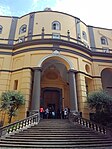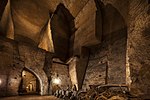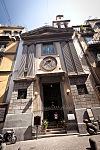Nunziatella (church)

The Church of the Nunziatella is a Baroque-style church located inside the grounds of the military school of Nunziatella, in the quartiere of San Ferdinando in Naples, Italy.The Baroque style church was built in 1588 with the patronage of Anna Mendoza Marchesa della Valle, who donated the church to the Jesuits. In 1736, it was rebuilt wholly anew by the architect Ferdinando Sanfelice. In 1773, with the suppression of the Jesuit order, the complex was under the jurisdiction of Somaschi brothers, who established a college for sons of the Knights of Malta. The next year this became the Royal Military College and the Somaschi moved to the church of Gesù Vecchio. The church since then has become the chapel of the Nunziatella Military Institute. Originally, the church was dedicated to the Virgin of the Annunciation, but popularly the church was known as the "Annunziatella" o "Nunziatella", to distinguish it from the Basilica of Santissima Annunziata Maggiore. The name passed on to the adjacent military school.
Excerpt from the Wikipedia article Nunziatella (church) (License: CC BY-SA 3.0, Authors, Images).Nunziatella (church)
Via Generale Luigi Parisi, Naples San Ferdinando
Geographical coordinates (GPS) Address External links Nearby Places Show on map
Geographical coordinates (GPS)
| Latitude | Longitude |
|---|---|
| N 40.8329 ° | E 14.244668 ° |
Address
Chiesa della Nunziatella
Via Generale Luigi Parisi
80132 Naples, San Ferdinando
Campania, Italy
Open on Google Maps









